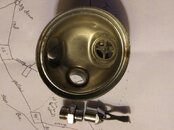Yes, all the components can be fully removed from the body (photo is better than words). No plastic tips on lever.Looking at Kupu's post and photos it looks like the guts of the really early 108's could be removed from the body. ? ! I wonder if Kupu's double valve 108 also has the plastic tipped lever?.




